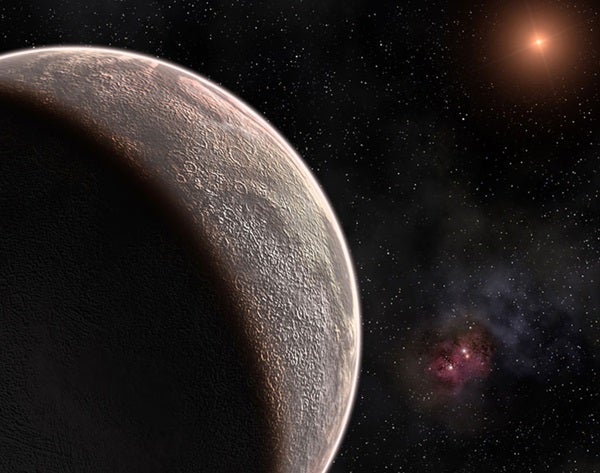Scientists using an observational technique that exploits Albert Einstein’s theory of gravity report the discovery of a planet just 5.5 times Earth’s mass. The new world, located in Sagittarius toward the Milky Way’s center, orbits a cool M-dwarf star 21,500 light-years away.
“This finding means that Earth-mass planets are not that uncommon,” says Kailash Sahu of Baltimore’s Space Telescope Science Institute and a member of the discovery team. “If we found one, there must be more.”
The new world is the first discovered around another star that agrees with astronomers’ theories of how planetary systems form. Princeton astronomer Bohdan Paczynski explains: “Around red dwarfs, the theory predicts Earth- and Neptune-sized planets to be more common than Jupiter-sized planets. The planets would be located between 0.1 and 10 times the Earth-Sun distance from their stars.”
The new planet falls into the correct mass range, between Earth’s and Neptune’s masses, and orbits its star 2.6 times farther than Earth orbits the Sun.
In 1991, Paczynski and then-student Shude Mao proposed searching for extrasolar planets using a technique called gravitational microlensing. Distant starlight becomes temporarily magnified when a background star aligns with a foreground object along the line of sight to Earth. Lensing events can last for weeks as the two stars first enter, then exit, the critical alignment.
The Optical Gravitational Lensing Experiment (OGLE) regularly monitors 170 million stars in the galaxy’s central region for telltale flare-ups caused when a foreground star drifts into alignment with a background star.
“With this method, we let the gravity of a dim, intervening star act as a giant natural telescope for us, magnifying a more distant star, which then temporarily looks brighter,” explains team member Andrew Williams of Australia’s Perth Observatory. A small “defect” in the brightening reveals the existence of a planet around the lens star. “We don’t see the planet, or even the star that it’s orbiting, we just see the effect of their gravity,” he says.
On July 11, 2005, OGLE’s early warning system announced a relatively bright G-type star was undergoing a microlensing event. Astronomers with OGLE, the Probing Lensing Anomalies Network (PLANET) team, and the Japan/New Zealand Microlensing Observations in Astrophysics (MOA) collaboration monitored the event.
On August 10, the PLANET team discovered an additional brightening as the event waned. This meant another mass near the lens star was also amplifying light from the background star. An OGLE telescope also detected the change the same night; the MOA team later confirmed the planetary signature.
Since 1991, astronomers have cataloged more than 150 planets orbiting other stars. Most of those found orbiting Sun-like stars are Jupiter’s mass or more. The most widely used detection technique, which senses an orbiting planet through the motion it imparts to its star, paints a distorted portrait of our galaxy’s planetary population. The technique is most sensitive to massive planets circling very close to their parent stars.
But, says University of Notre Dame astronomer David Bennett, the microlensing method, in use since 1998 and now catching hundreds of events each year, should have found dozens of exo-Jupiters by now if they were so common.
Prior to this discovery, the smallest exoplanet known was GJ876d. Astronomers believe this planet is less than half Neptune’s mass, or 7.3 &plusmin; 1 Earth masses. The new planet’s is less certain — its possible mass ranges from 2.8 to 11 Earth masses. Nevertheless, say researchers, the microlensing technique is the only method currently capable of finding planets with similar masses to Earth’s.
Scientists say OGLE-2005-BLG-390Lb is too small to have held together if it were a gas-giant like Jupiter or Neptune. Instead, astronomers believe the new world is a mixture of ice and rock and may possess a thin atmosphere. Its M-type star has only 22 percent the mass of our Sun and puts out a feeble light. Although the planet circles the star at less than 3 times the Earth-Sun distance, astronomers believe its surface temperature is –364° Fahrenheit (–220° C).











